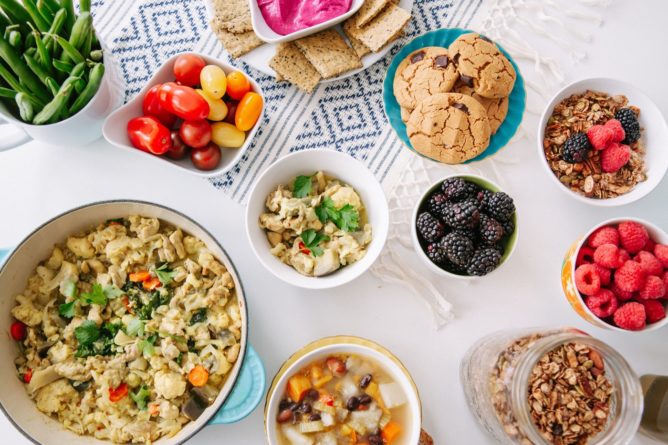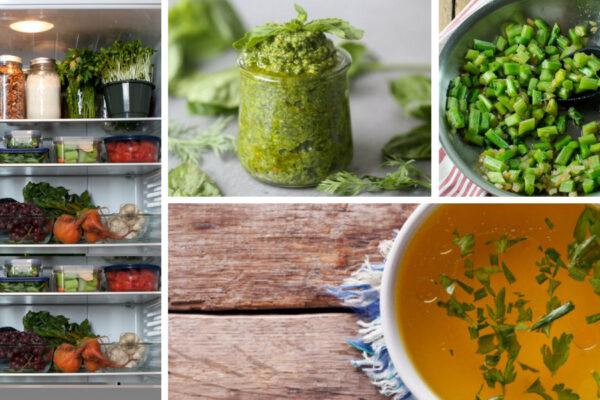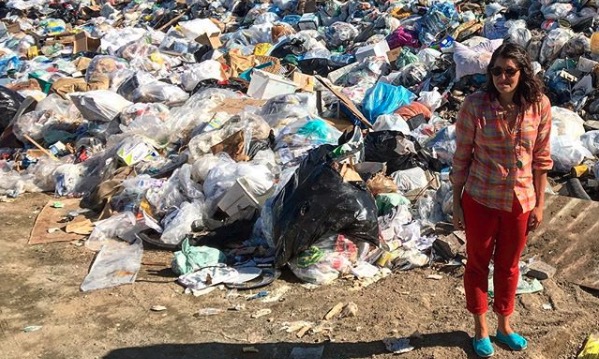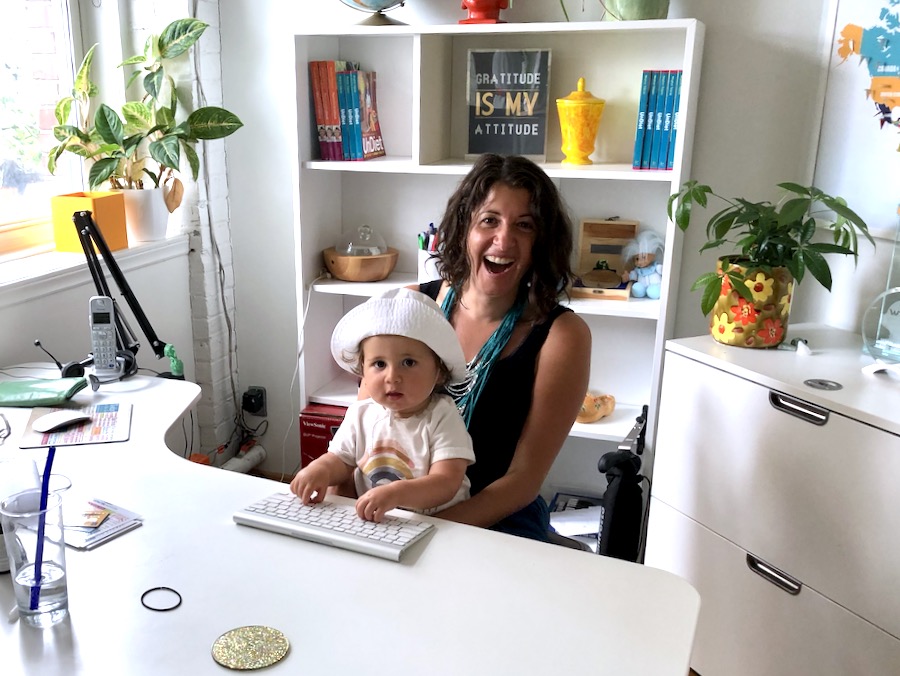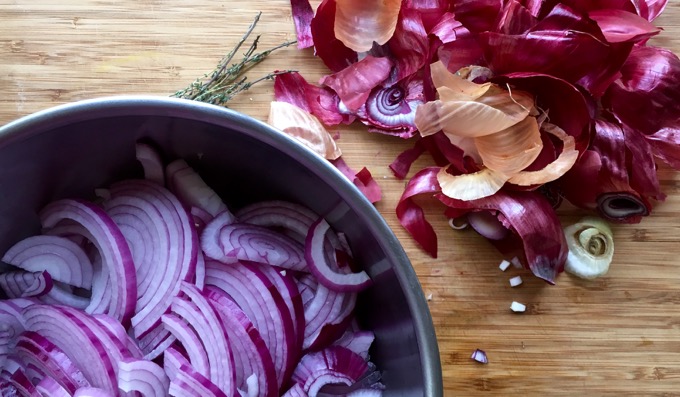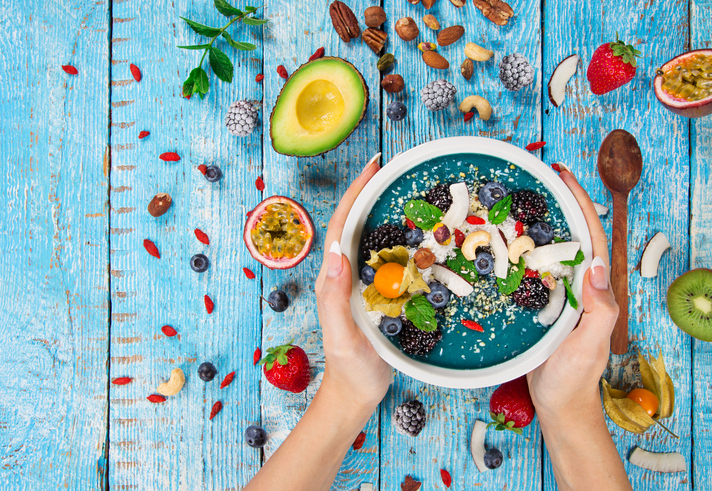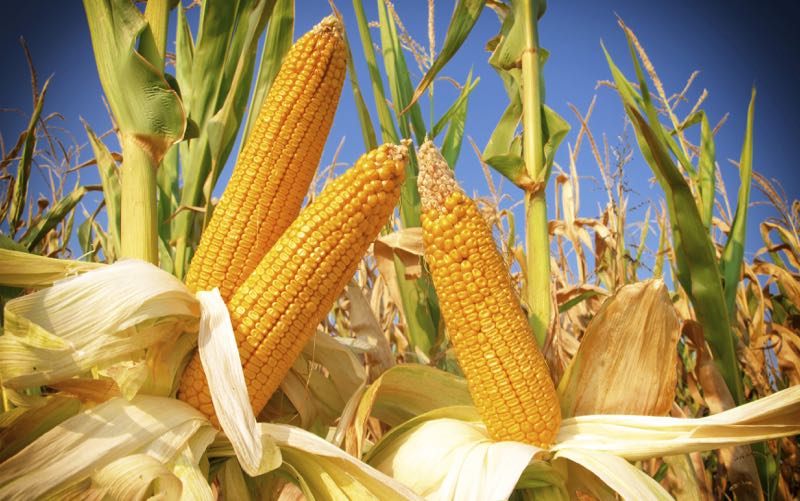When I Couldn’t Stop Thinking About Garbage, This Happened
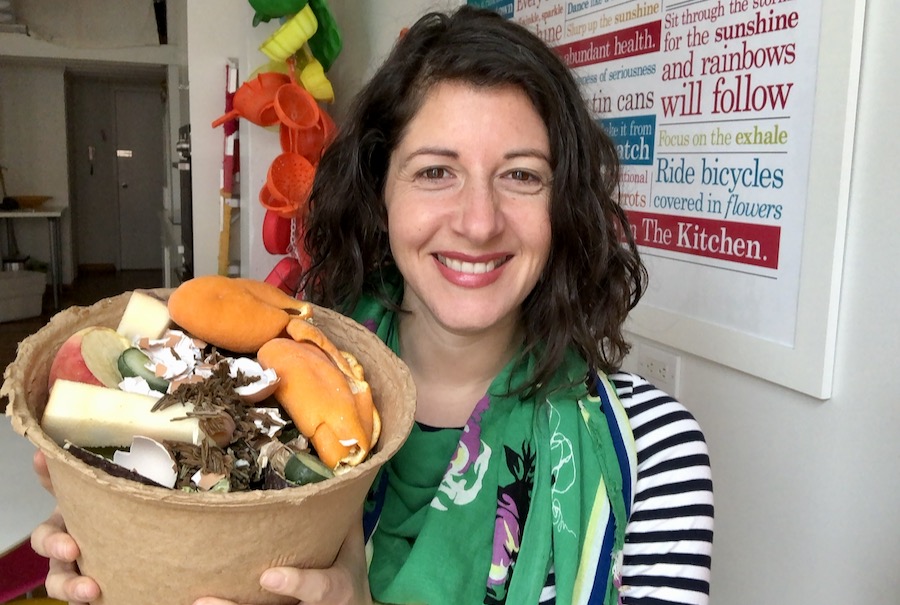
That photo above is me and my garbage. Specifically, this is three months worth of waste made from my at-work lunches. One small bin of food scraps. I should also mention that I’ve been keeping it in the freezer and adding to it. This has not been sitting out at room temperature all that time! We run a litter-less lunch program here at Meghan Telpner Inc. I am only half-joking here; my entire staff is remote and works from home, except me, and they are all from-scratch cookers and I feel confident in saying they don’t eat on paper plates at home. I pack my lunch every day in reusable containers and so the only waste I typically have is fruit peels, cores, the occasional eggshell or avocado pit. Yes, there are great restaurant options where my office is, but part of my commitment to making less waste, striving for minimalism, and maximizing health means that I pack my lunch.
The amount of waste we make in our household is something I’ve been thinking about a lot lately – in fact, sometimes it keeps me up at night. While my husband, son and I live a very minimalist lifestyle, I still worry that it’s not enough. Here in North America, we generate the highest amount of waste in the world: about 2.2 kg per person per day, which is almost double the second-highest region (Europe and South Asia), averaging 1.18 kg per person daily. Do you think about the garbage you create? I could scare you to tears with statistics but I recognize that I can’t change the entire world. I can only change my own behaviour and put forth my best effort to make a difference – as I wholeheartedly know that every little bit helps. And perhaps, there’s a chance that if I share my experience and efforts, someone else (um, you?) might be inspired to try a few things.
The Sources of Household Waste We Don’t Think About
Here in Toronto, every week the trucks come and haul away the garbage and most of us don’t think about it. But I do think about it. I think about the bins that line my own street. And then I think about the bins that line all the streets in my neighbourhood, my city, my country, and the world. The thing is, many companies are starting to change their packaging products which is amazing, but we’re not shopping less. I am not telling everyone to stop shopping and stop supporting local economies. This is quite the opposite. What if we bought less in quantity and more in quality. We could spend the same but have fewer things that last longer.
How can we make less garbage?
The garbage we create comes from a variety of sources. But there are also simple ways to reduce it.
- Food waste: meal plan, take leftovers for lunch, prep your veggies at the start of the week, freeze leftovers.
- Non-recyclable and recyclable plastics: Buy less that comes in plastic. Let the packaging be part of your decision making and if there is a plastic-free option available, get it.
- Personal care products and beauty products: Buy less and again, let the packaging be part of your decision-making process.
- Home cleaning products: Make your own wherever possible, and find a refill depot near you to refill the containers you already have.
- Yard waste: This one is unavoidable but composting what you can will reduce what needs to get hauled away.
- Technology (phones, iPads, computers, etc.): Upgrade less often! This is such a simple one. We do not need the latest of everything. Use what you have for as long as you can. There are a lot of companies, including Apple, who have trade-in programs for old and broken electronics (computers, phones). These products get properly fixed and sold again (or their parts may get reused), and the consumer makes money as a result.
- Children and toddler toys: Choose toys that can grow with your child’s development, that has building capacity rather than one-time kits. Be mindful of the packaging, buy second hand, sell your old stuff, and avoid plastic toys which will break much more easily.
- Clothing: Buy less clothing and consider the quality of what you are buying, the versatility and the impact of it. And then when you are done with something, consider whether it can be repaired or altered to get a second life, donated or recycled appropriately.
- Gifts: Give and ask for experiences, second-hand gifting, donations, or ask for and give edible gifts.
- Food packaging, or packaging from non-food items: Consider the packaging when making purchasing decisions, make requests of companies to use more sustainable options, and avoid food packaging altogether, and make more from scratch.
- Paper and cardboard: One of the biggest sources of this is packaging from online shopping. Is it possible to reduce the number of orders so less packaging is needed, and of course, shopping local as much as possible and bringing your own bags will help.
I am not personally attempting a complete zero-waste lifestyle, but we are getting closer with every new decision and effort we are making to be more mindful. What if we all do our best, however imperfectly that may be? That is how and where we can make a difference.
So much of the household garbage we are all making (see that list above) could be dramatically reduced without a dramatic change in habits, just a change in how we make decisions and what those decisions are. It matters.
How We Are Taking Steps to Reduce the Garbage We Create
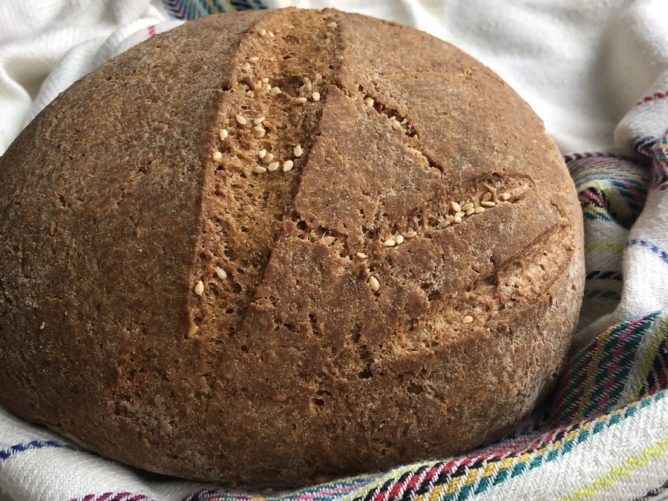
In our household, we are always striving to do better. These are some of the things that Josh and I have started doing in the last year to reduce the amount of packaging and waste we produce. As an added benefit, these things have also saved us money!
- Refilling soap/etc. at refill stores
- Making our own sourdough bread, bagels, crackers, tortillas and most recently, tortilla chips
- Batch prepping nut and seed milk and coconut milk
- Making fermented foods, including yogurt, sauerkraut, pickles, nut cheese, etc.
- Reducing the number of toys we bring into the house for our son and finding hand-me-down toys from friends or in the neighbourhood
- Making our own hummus and other dips that normally come in plastic packages
- Bringing our own jars to refill for bulk items
- Bringing glass containers to the butcher and fish shop to avoid the plastic-wrapped options (and also buying from the counters, rather than the pre-packaged)
- Bringing containers to restaurants for leftovers
- What we can’t get from local shops in refillable jars, we are aiming to buy in bulk
- Reducing the amount of online shopping to the essentials and ensuring we have things shipped together rather than in separate packages
- Mending/repairing clothing, toys, and other household items
These changes initially took a bit more time and effort, but once we integrated them into our schedules it was much, much easier. Plus, it’s important for us to spend our time on food preparation – it’s relaxing and enjoyable, gives us bonding time as a family, and teaches us and our son new skills. And who are we kidding – everything we make it absolutely delicious!
My son had this plastic truck that was gifted to him and he loves it. A moving part cracked off, as often happens with plastic. He looked up at me said, “It’s okay mommy, we can fix it”. We can’t actually, because, well, it’s plastic – but his attitude and spending the weekends with us cooking and doing repairs has already instilled in him that it’s just the way we roll. That’s the biggest win of all.
Reducing Garbage: The Motivation Behind My New Course
And this all brings me to Everyday Culinary Nutrition. When I visit the grocery store, it’s easy to get excited about the number of healthy products on the shelves like gluten-free crackers, coconut cream, organic green juice, dairy-free chocolate, and more. But then two things happen:
- Sometimes when I looked more closely at labels, even the healthy/organic products had sub-optimal elements like excess sugar (even the natural sweeteners), hidden MSG, preservatives or natural flavours. It is also easy to be fooled by packaging that seemed green and natural through their visuals but really weren’t healthy at all.
- Even when a food product has an ingredient list I love, I couldn’t get past the packaging. It just didn’t make sense for me to bring more plastic or cardboard into my home that probably wouldn’t be recycled properly when I could easily make those items myself.
And so Everyday Culinary Nutrition was born. This brand-new course teaches everyday meals and staples that are delicious, quick and easy to make, and good for us. Plus, making more healthy food at home will help reduce your household food and packaging waste, and save you money.
You can grab all the course details and join us here – plus listen to a mini bonus episode of our Today Is The Day Podcast about How to Make Culinary Nutrition Part of Everyday Eating.
Additional Resources to Help You Reduce Waste
- 5 Ways to Store Food Without Plastic
- 31 Waste-Free Celebration Ideas
- 10 Ways to Cut Down On Your Food Waste
- Guide to Vintage Shopping
- 20 Best Natural Beauty Care Recipes
- My Experiment in Minimalism
- Choosing Toddlers’ Toys: Marie Kondo Style
- Unexpected Sources of Microplastics
- 10 Non-Toxic Home Cleaning Recipes
- Shocking Environmental Impact of Popular Health Foods
- Food Packaging Tricks That Fool Us
None of this is complicated. It just takes some level of initial forethought.
Free Resource Library
Enjoy more than 40 downloadable guides, recipes, and resources.















